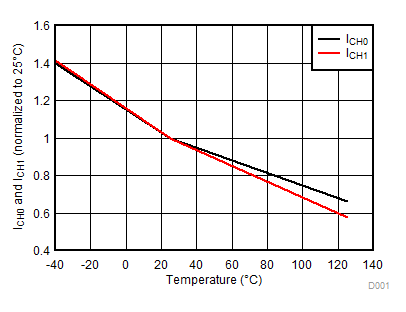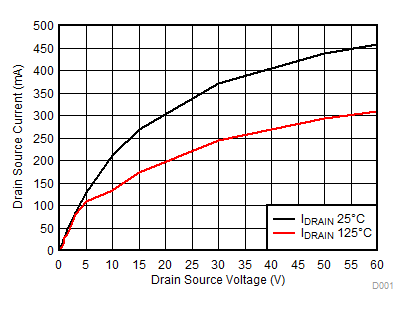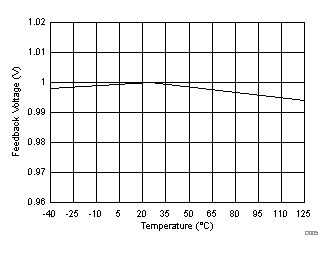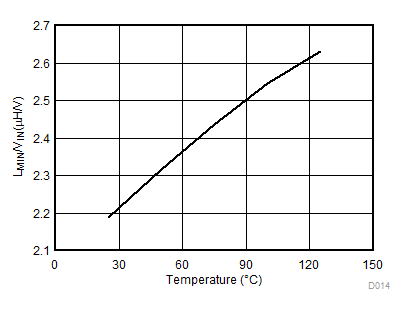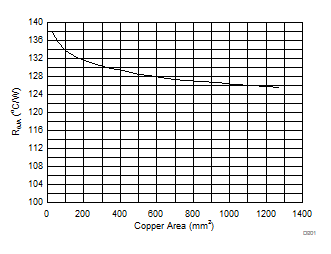SLUSC05D July 2014 – May 2016 UCC28880
PRODUCTION DATA.
- 1 Features
- 2 Applications
- 3 Description
- 4 Revision History
- 5 Pin Configuration and Functions
- 6 Specifications
- 7 Detailed Description
-
8 Application and Implementation
- 8.1 Application Information
- 8.2
Typical Application
- 8.2.1
12-V, 100-mA Low-Side Buck Converter
- 8.2.1.1 Design Requirements
- 8.2.1.2
Detailed Design Procedure
- 8.2.1.2.1 Custom Design with WEBENCH Tools
- 8.2.1.2.2 Input Stage (RF, D2, D3, C1, C2, L2)
- 8.2.1.2.3 Regulator Capacitor (CVDD)
- 8.2.1.2.4 Freewheeling Diode (D1)Freewheeling Diode (D1) section.
- 8.2.1.2.5 Output Capacitor (CL)
- 8.2.1.2.6 Load Resistor (RL)
- 8.2.1.2.7 Inductor (L1)
- 8.2.1.2.8 Feedback Path (Q1, RFB1, RFB2)
- 8.2.1.3 Application Curves
- 8.2.2 12-V, 100-mA, High-Side Buck Converter
- 8.2.3 Additional UCC28880 Application Topologies
- 8.2.1
12-V, 100-mA Low-Side Buck Converter
- 9 Power Supply Recommendations
- 10Layout
- 11Device and Documentation Support
- 12Mechanical, Packaging, and Orderable Information
6 Specifications
6.1 Absolute Maximum Ratings
over operating free-air temperature range (unless otherwise noted) (1)(2)(5)| MIN | MAX | UNIT | ||
|---|---|---|---|---|
| HVIN | –0.3 | 700 (3) | V | |
| DRAIN | Internally clamped | 700(3) | V | |
| IDRAIN | Positive drain current single pulse, pulse max duration 25 μs | 320(6) | mA | |
| IDRAIN | Negative drain current | –320 | mA | |
| FB | –0.3 | 6 | V | |
| VDD | VDD is supplied from low impedance source | –0.3 | 6 | V |
| IVDD | VDD is supplied from high impedance source | 400 | µA | |
| TJ(4) | Junction temperature | 150 | °C | |
| Lead temperature 1.6 mm (1/16 inch) from case 10 seconds | 260 | °C | ||
| Tstg | Storage temperature range | –65 | 150 | °C |
(1) Stresses beyond those listed under Absolute Maximum Ratings may cause permanent damage to the device. These are stress ratings only, which do not imply functional operation of the device at these or any other conditions beyond those indicated under Recommended Operating Conditions. Exposure to absolute-maximum-rated conditions for extended periods may affect device reliability.
(2) All voltages are with respect to GND. Currents are positive into, negative out of the specified terminal. These ratings apply over the operating ambient temperature ranges unless otherwise noted.
(3) TA = 25°C
(4) The thermal shutdown threshold can be beyond the absolute maximum rating of the junction temperature. Thermal shut down is designed to prevent thermal run away that could result in catastrophic failure. Prolonged operation above recommended maximum junction temperature can impact device life time
(5) The device is not rated to withstand operating conditions when multiple parameters are at or near, absolute maximum ratings.
(6) The MOSFET drain to source voltage is less than 400V
6.2 ESD Ratings
| UNIT | ||||
|---|---|---|---|---|
| V(ESD) | Electrostatic discharge | Human Body Model (HBM), per ANSI/ESDA/JEDEC JS-001, all pins except HVIN pin(1) | ±2000 | V |
| Human Body Model (HBM) per ANSI/ESDA/JEDEC JS-001, HVIN pin (1) | ±1500 | V | ||
| Charged device model (CDM), per JEDEC specification JESD22-C101, all pins(2) | ±500 | V | ||
(1) JEDEC document JEP155 states that 500-V HBM allows safe manufacturing with a standard ESD control process.
(2) JEDEC document JEP157 states that 250-V CDM allows safe manufacturing with a standard ESD control process.
6.3 Recommended Operating Conditions
over operating free-air temperature range (unless otherwise noted)| MIN | NOM | MAX | UNIT | ||
|---|---|---|---|---|---|
| VVDD | Voltage On VDD pin | 5 | V | ||
| VFB | Voltage on FB pin | –0.2 | 5 | V | |
| TA | Operating ambient temperature | –40 | 105 | °C | |
| TJ | Operating junction temperature | –40 | 125 | °C | |
6.4 Thermal Information
| THERMAL METRIC(1) | UCC28880 | UNIT | |
|---|---|---|---|
| D (SOIC) | |||
| 7 PINS | |||
| RθJA | Junction-to-ambient thermal resistance | 134.4 | °C/W |
| RθJC(top) | Junction-to-case (top) thermal resistance | 42.6 | °C/W |
| RθJB | Junction-to-board thermal resistance | 85 | °C/W |
| ψJT | Junction-to-top characterization parameter | 6.4 | °C/W |
| ψJB | Junction-to-board characterization parameter | 76 | °C/W |
(1) For more information about traditional and new thermal metrics, see the Semiconductor and IC Package Thermal Metrics application report, SPRA953.
6.5 Electrical Characteristics
VHVIN = 30 V, TA = TJ = –40°C to +125°C (unless otherwise noted)6.6 Switching Characteristics
over operating free-air temperature range (unless otherwise noted)| MIN | TYP | MAX | UNIT | |||
|---|---|---|---|---|---|---|
| fSW(max) | Maximum switching frequency | 52 | 62 | 75 | kHz | |
| tON_MAX | Maximum switch on time (current limiter not triggered), FB = 0.75 V | 6.5 | 8.1 | 9.7 | µs | |
| tOFF_MIN | Minimum switch off time follows every tON time, FB = 0.75 V | 6.5 | 8.1 | 9.7 | µs | |
| tMIN | Minimum on time | 0.17 | 0.22 | 0.30 | µs | |
| tOFF(ovl) | Max off time (OL condition), tOFF(ovl) = tSW – tON(max) | 130 | 200 | 270 | µs | |
| ton_TO | Inductor current run away protection time threshold | 500 | ns | |||
6.7 Typical Characteristics
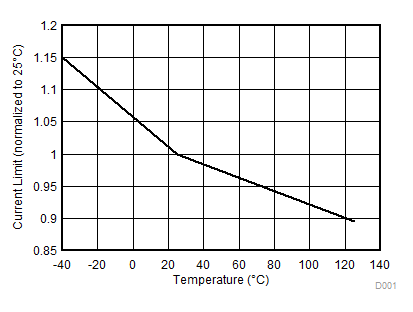
A.
Figure 1. ILIMIT vs Temperature
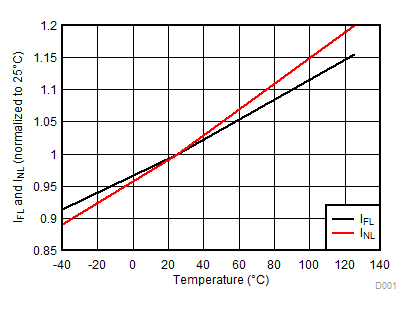
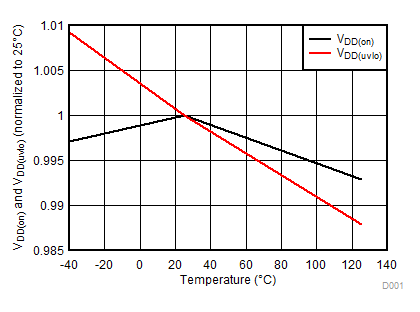
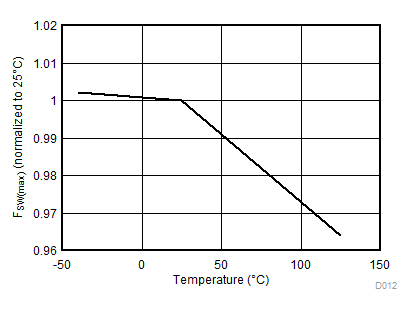
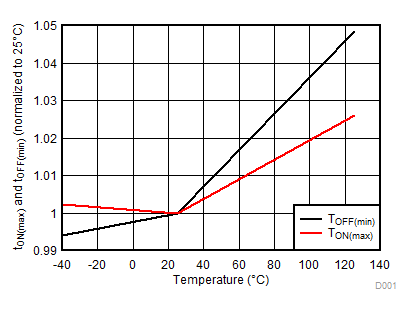
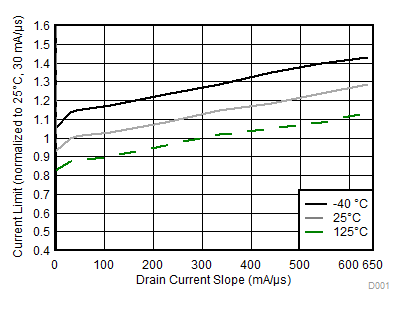
A.
Figure 2. ILIMIT vs Drain Current Slope
